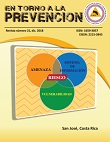| Resumen: |
De
acuerdo con el Inventario Nacional de Humedales 2018 (Proyecto
Humedales, 2018), existen en el país 282.941,98 ha de humedales
lacustres, palustres y estuarinos distribuidos en 10.699 unidades en
todo el territorio. En 1991 los humedales de la Cuenca Baja del Rio
Tempisque (CBRT) fueron reconocidos como sitios Ramsar de importancia
internacional, por lo que el Estado costarricense se comprometió a
manejarlos de forma sostenible, para asegurar así su conservación y uso
racional. Los humedales de la CBRT constituyen uno de los sistemas
lenticos estacionales más importantes del Pacífico Mesoamericano (EARTH
s/f). De acuerdo con SINAC-PNUD 2014, los humedales del país se han
sobreexplotado causando el deterioro de los ecosistemas y
comprometiendo el bienestar y las posibilidades de desarrollo de sus
pobladores. Las comunidades de la CBRT no están exentas de este
fenómeno y enfrentan una problemática social muy fuerte derivada de sus
modelos de desarrollo, donde su bienestar se ve doblemente comprometido
debido a su dinámica social y a factores ligados al clima. El aumento
de la temperatura y los cambios estacionales en algunos casos extremos,
afectan estas áreas y obligan a replantearse “nuevas” formas de
desarrollo sustentables y a iniciar procesos de transformación social y
ecológica (CONARE, 2017). La CBRT cuenta con un Plan de Gestión Local
(PGL) que es el instrumento guía para el trabajo articulado entre los
actores sociales y el Estado costarricense para el período 2018-2022.
Este instrumento de planificación fue validado por las autoridades del
refugio en diciembre 2017. El mismo, se concibe como el instrumento
para la implementación del Plan General de Manejo (PGM) del Área
Silvestre Protegida, elaborado en 2012 (SINAC 2017). El PGL definió 4
ejes estratégicos como líneas de acción que responden a las necesidades
identificadas en el Sitio Ramsar: rehabilitación de espejos de agua,
esteros y drenajes naturales, recuperación de la cobertura boscosa,
fortalecimiento de capacidades institucionales y comunales y gestión
del recurso hídrico (SINAC 2017). Este artículo presenta la experiencia
interinstitucional que se ejecutó para desarrollar el eje estratégico
de “Recuperación de cobertura boscosa”, como se presenta el objetivo:
“Recuperar la cobertura boscosa o forestal de las áreas de protección
de las nacientes, ríos, lagunas y esteros”. El Proyecto de
Reforestación fue ejecutado por la Asociación de Ganaderos de El
Rosario. El proyecto de Humedales facilitó los recursos para la compra,
siembra y mantenimiento del primer año del proyecto. El SINAC junto con
la comunidad, se comprometieron a dar seguimiento, cuido y asesoría
forestal por dos años a los árboles que fueron sembrados.
Adicionalmente UNA-UCR y CNE apoyarán el cuido de los árboles durante
2018-2019. Durante los meses de octubre y noviembre del 2017 se
plantaron y fertilizaron 625 árboles de especies nativas En Julio 2018
se realiza la primera evaluación de la iniciativa. Los resultados de
esta evaluación mostraron serias deficiencias en torno al mantenimiento
dado a los árboles desde su establecimiento. Se encontró un porcentaje
de mortalidad del 31,64% asociado principalmente a estrés hídrico y
ramoneo.
According to the National
Wetland Inventory 2018 (Wetlands Project, 2018), there are 282,941.98
ha of wetlands in the country distributed in 10,699 units throughout
the country. In 1991 the wetlands of the Lower Basin of the Tempisque
River (CBRT) were recognized as Ramsar sites of international
importance. Since that period, the Costa Rican State took the
compromiso to ensure their conservation and rational use. The wetlands
of the CBRT constitute one of the most important seasonal lentic
systems of the Mesoamerican Pacific (EARTH s / f). According to
SINAC-PNUD 2014, the country’s wetlands have been overexploited causing
the deterioration of ecosystems and compromising the welfare and
development possibilities of its inhabitants. The communities of the
CBRT are not exempt from this phenomenon and face a very strong social
problem derived from their development models, where their welfare is
doubly compromised due to their social dynamics and factors linked to
climate. The increase of the temperature and the seasonal changes in
some extreme cases, affect these areas and force to rethink “new” forms
of sustainable development and to initiate processes of social and
ecological transformation (CONARE, 2017). The CBRT has a Local
Management Plan (PGL) that is the guiding instrument for the
articulated work between the social actors and the Costa Rican State
for the period 2018-2022. This planning instrument was validated by
authorities in December 2017. It is conceived as the instrument for the
implementation of the General Management Plan (PGM) of the Protected
Wildlife Area, prepared in 2012 (SINAC 2017). The PGL defied 4
strategic lines of action that respond to the needs identifid in the
Ramsar Site: rehabilitation of water mirrors, estuaries and natural
drainages, recovery of forest cover, strengthening of institutional and
communal capacities and management of water resources (SINAC 2017).
This article presents the interinstitutional experience that was
carried out to develop the strategic line: Recovery of forest cover.
The Reforestation Project was executed by the Livestock Association of
El Rosario. The Wetlands project facilitated the resources for the
purchase, planting and maintenance of the fist year of the project.
SINAC, together with the community, undertook to provide follow-up,
care and forestry advice for two years to the planted trees.
Additionally UNA-UCR and CNE will support the care of the trees during
2018-2019. During the months of October and November 2017, 625 trees of
native species were planted and fertilized. In July 2018 the fist
evaluation of the initiative took place. The results of this evaluation
showed 10 Revista Nº. 21, dic. 2018 serious defiiencies regarding the
maintenance given to the trees since their establishment. A percentage
of mortality of 31.64% was found, mainly associated with water stress..
|

